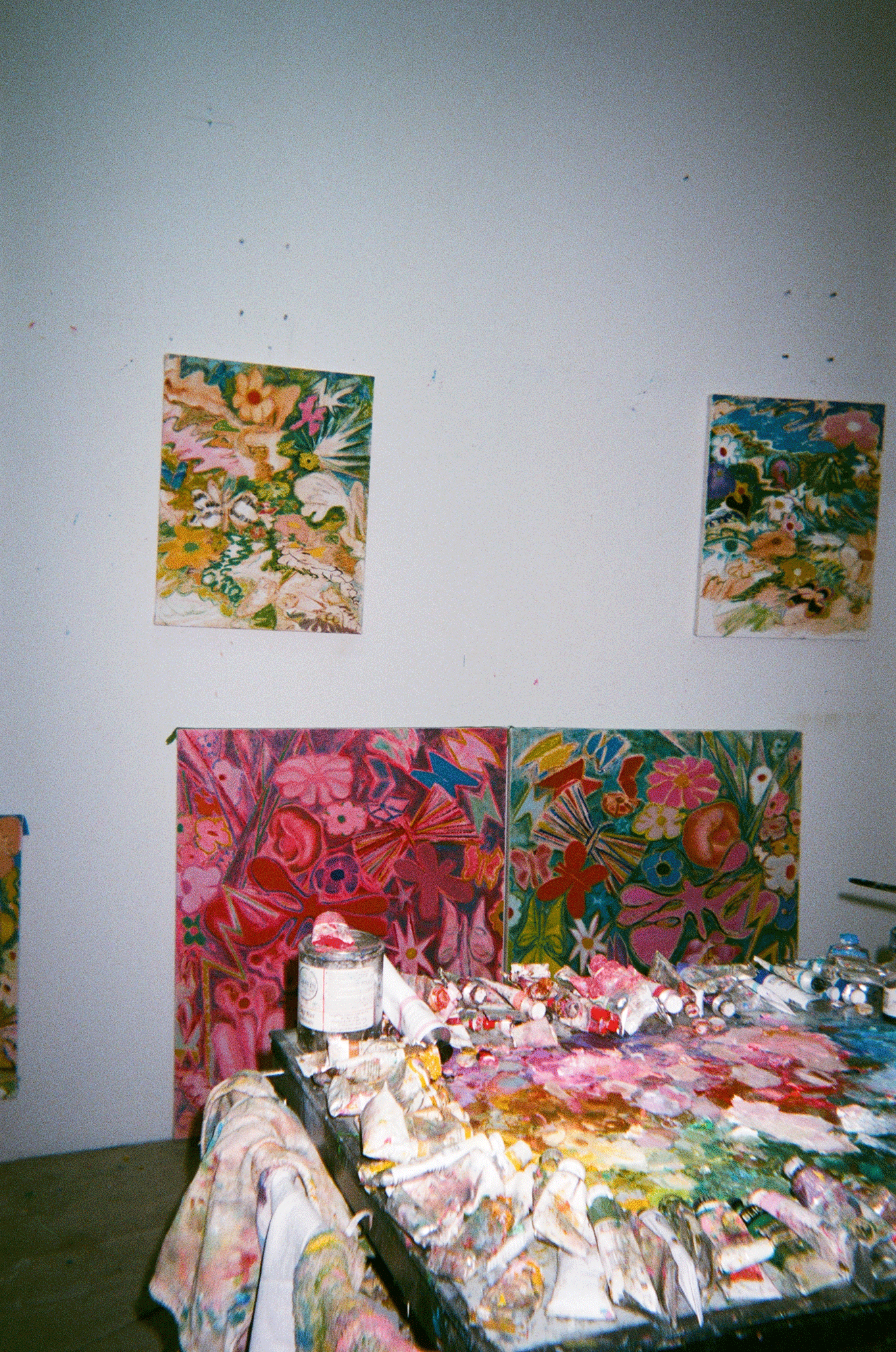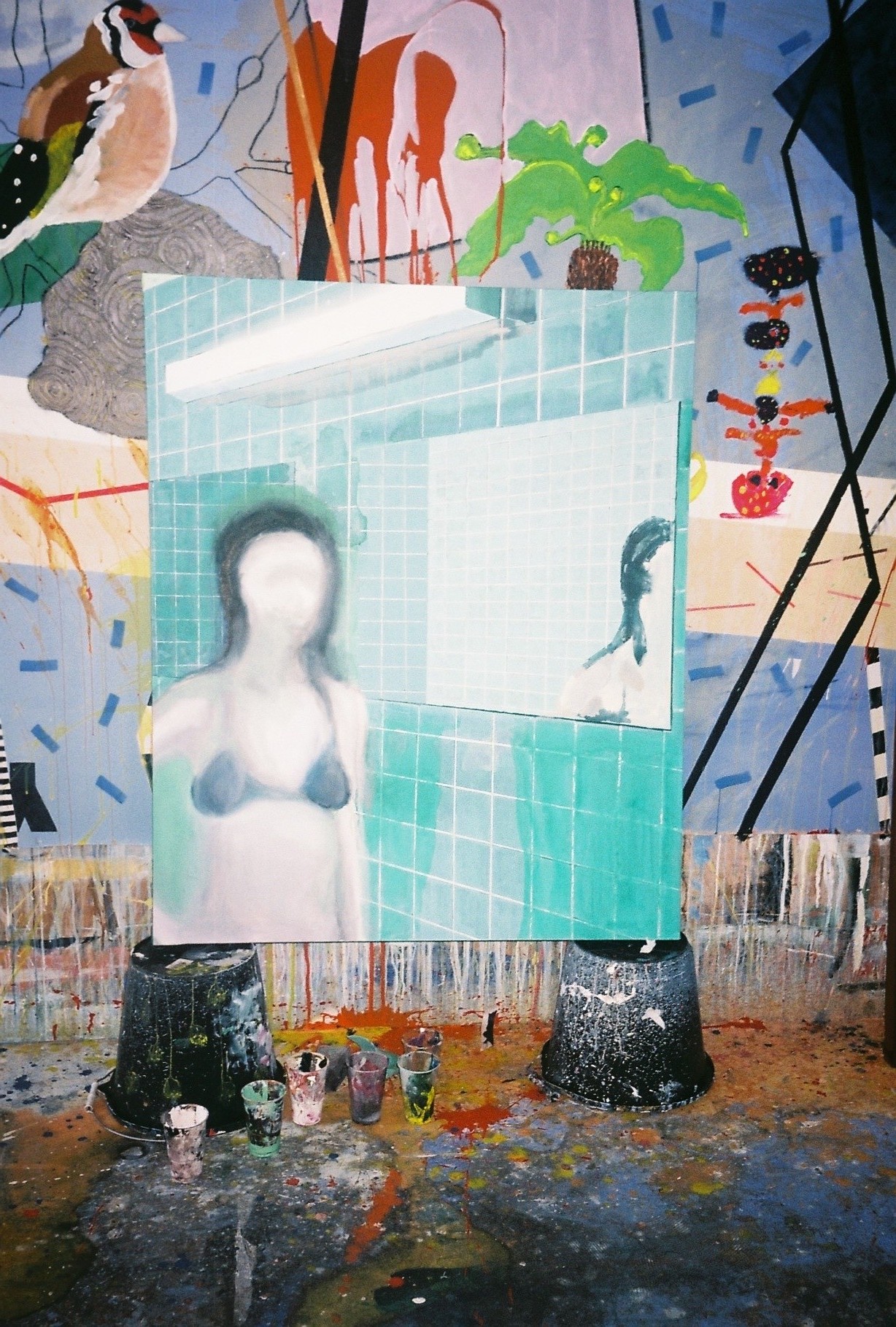





Depicting the world in a way she wishes it to be seen.
Located in Highland Park, Los Angeles, artist Laurie Nye speaks with DATEAGLE ART at her studio about why she uses her practice to delve into an alternate universe, a visionary space that depicts the world in a way she wishes it to be seen. While her distinct canvases, with their vibrant colour palette may be interpreted as utopic scenes, Nye uses her art form to express the frustration she feels towards mankind and their lack of respect for the planet. Until recently, Nye merged geometric patterns with abstract forms. However, since viewing Women of Abstract Expressionism and specifically the work of Lee Kransner, at Palm Springs Museum of Art, Nye has gradually moved towards a more fluid, instinctual style. While her lexicon adapts, Nye continues to celebrate her invented muses – hybrid beings from an alternate galaxy that symbolise infinite compassion and transformation. These biomorphic forms are an alternative, better-suited gender, through which Nye manifests her frustration with the harsh realities of nature’s unfortunate predicament. Her painterly approach is powerfully subtle, leaving the spectator with a poignant message; how do we view our relationship with nature and what are we doing to contribute to its survival?

PROCESS
When visiting you at the studio we discussed whether your works are utopian, whereby you explained that if anything they are highlighting mankind’s determination to tame nature – so quite the opposite. Can you explain this element of the work in more detail?
It has to do with mankind’s struggle to control its relationship with nature. We are in a time of great crisis, where many humans at polar extremes, either trying desperately to create a fix for global-warming and generate sustainable practices or completely denying it and rushing to exploit our last pristine forests with great speed. People are migrating in masses because of droughts. Eco-activisits are being murdered for their efforts to stop dams on indigenous lands. Humans are losing our closeness with the land that originally provided us nourishment and the secrets of a good life. Our societies thirst for the easy conveniences seem to be outpacing our valuable resources. Palm oil is killing forests and pushing out animals and killing old growth forests. Stop eating Cheetos and drinking Cola, people… I’m truly frustrated with what I see manifested in our natural world today and the people in charge of its demise (mostly patriarchal) because of short-sighted greed. So I choose to envision our world through another lens, a more hopeful one, run by a better-suited gender.
Can you tell me about your process? Do you often begin with preliminary drawings that unfold into the larger canvases?
I have in the past worked that way, sometimes from thumbnails, but have not been using any pre-sketching lately. I don’t have a plan, but forms appear after I start making lines on the canvas. My drawings do get into my head and then inform my paintings in various ways.


What is your standard routine when working in the studio?
I bring my dog with me so it’s about getting her settled first. I put my apron on and depending on the mood I play audio books or music to generate mood. I’ve been listening on repeat to the audiobook, “The Master and Margarita” , Georgia O’Keefe’s biography, and The Breeders… Sometimes I look at my art books to get excited and think about ways of using colour. I tend to work on a few things at a time but right now I’m working through the process of a shift. I’m trying to figure something out and its concentrated on a singular painting. It’s either frenetic in my studio or it’s really slow and focussed.
WORK
Your works have a timeless quality, one where gravity and ultimately reality appears to be defied – a mixture of mythology and science fiction. Would you say that you like to play with contradiction in your work?
Totally. I’m interested in the juxtaposition of future and past, real and unreal, reality vs mythos.
Your work has ethereal, otherworldly qualities. Can you tell me how you came to form your distinct aesthetic?
Over time I think the motifs and ideas that I continue to be drawn to always return me to a visionary space. I depict places and things the way I’d like to see them. Maybe I’ve never seen these places before or maybe they are echoes from the recesses of visual memory.

Can you tell me what the muses in your work stand for? To me, they pay homage to the Devine Feminine.
I’d say yes and it’s a bit more complicated.. Over the past few years I’ve been “collaborating” with invented muses from another dimension/galaxy (Andromeda). They are hybrid she-beings; part-machine and part-nature. Their imperative has to do with restoring ecological balance to the universe. I invented them in order to offer myself some powerful symbols of infinite compassion and transformation to counter the reality of destructiveness playing out in our world at this time.
Given your invested interest in nature, do you prefer to paint en plein air?
I sometimes do enjoy painting or drawing outside but it comes more from my experience of nature. I spend my summers in verdant Tennessee where I grew up and travel around the Ozarks in Arkansas, to be near the cold rivers there. Those places were imprinted in my imagination since I was a child. I tend to paint it the way I see it in my mind.

I see your choice of colour as creating harmony and lyricism in your work – ultimately holding it all together. Would you agree?
Colour is an evolving and immense exploration for me. It’s certainly important in my work and tells a story of its own.
Would you say that your works are a personification of how you wish others to see the world or are you providing an escapism of some sort while also providing topical subliminal messages?
I’d say I paint pictures that I’d like people to want to enter into, and whether it’s an escape or a fantasy is really how the viewer is feeling. I do think there are messages and I hope people feel energy around my paintings.
How does Los Angeles influence your practice, if at all?
Colour! The bright sun is ever present and shining, it’s all about the light here. It affects the colour palette for certain. I want to paint muted tones but I have the feeling I will only achieve this if I put myself in a basement to paint.

FUTURE
Your practice is clearly at an exciting transitional phase as you seem to be phasing out the geometric qualities previously found in your work. Why do you think it is that you are moving more towards an abstract style?
Hmm, a few years ago my abstract painter friend, Caitlin Lonegan and I travelled out to the desert to see the “Women of Abstract Expressionism” exhibition at the Palm Springs Museum of Art. That show blew our minds. I’ve never seen so much incredible painting together in one place. It’s no wonder that most of these women were marginalised from the “great” male painter circles, they would have overshadowed them in many cases. Anyway, Lee Krasner’s work especially, was phenomenal and it stayed with me, I couldn’t totally shake it. I started drawing what I was feeling and it evolved my lexicon somehow. I don’t know that I’m moving away from image making but I am moving towards something more instinctual in terms of the moves I’m making.
05.12.18
Words by Lara Monro
Related
Interview

Peter Evans
Interview

